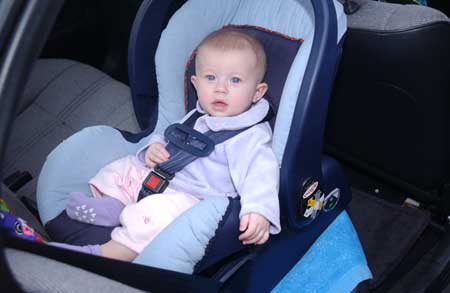National Child Passenger Safety Week, September 21–27, 2008
 Motor vehicle crashes are the leading cause of death among children in the United States, but many of these deaths can be prevented. Placing children in age– and size–appropriate car and booster seats reduces serious and fatal injuries by more than half, according to the National Highway Transportation Safety Administration (NHTSA).
The goal of National Child Passenger Safety Week is to bring public attention to the importance of safely transporting children. This week was formerly held in February, but has been moved to September to allow more opportunities for communities to hold car seat check events without the threat of inclement weather.
Motor vehicle crashes are the leading cause of death among children in the United States, but many of these deaths can be prevented. Placing children in age– and size–appropriate car and booster seats reduces serious and fatal injuries by more than half, according to the National Highway Transportation Safety Administration (NHTSA).
The goal of National Child Passenger Safety Week is to bring public attention to the importance of safely transporting children. This week was formerly held in February, but has been moved to September to allow more opportunities for communities to hold car seat check events without the threat of inclement weather.
The Problem:
- In the United States during 2006, 1,335 children ages 14 years and younger died as occupants in motor vehicle crashes, and approximately 184,000 were injured. That’s an average of 4 deaths and 504 injuries each day.¹
- Among children under age 5, in 2006, an estimated 425 lives were saved by car and booster seat use.¹
What You Can Do To Keep Your Child Safe:
- Seat all children ages 12 and younger in the back seat and be sure they are properly restrained every time they ride with you–even during those quick trips to the corner market. The resources below can help you find more detailed information about proper restraints including rear–facing seats, forward-facing seats, and booster seats.
- Read both your car (or booster) seat instruction manual and your vehicle owner’s manual to make sure you are properly installing and using the seat. One study found that 73% of nearly 3,500 observed child restraint systems were misused in a way that could increase a child’s risk of injury during a crash.²
- Send in your car seat registration card so that the manufacturer can contact you about any recalls. You can also call the NHTSA Auto Safety Hotline at &@40;888) 327–4236 to find out about recalls.
- Replace any car seat that was used during a motor vehicle crash.
How to Choose the Right Car or Booster Seat:
When choosing a car or booster seat, it's important to find one that is age–and size– appropriate and fits in your car. For tips on making this decision, visit the following web sites of CDC partners:
- Child Passenger Safety, National Highway Traffic Safety Administration
- Car Safety Seats: A Guide for Families 2008, American Academy of Pediatrics *
Once you choose a car or booster seat, you’ll need to learn how to install it properly in your car. Be sure to read the manuals for your car or booster seat and contact a trained technician in your community for hands-on assistance. The following web sites can help you find resources in your community:
- CDC directory of state and local health departments
- Safe Kids Worldwide
- Child Passenger Safety Inspection Stations, National Highway Traffic Safety Administration
Booster Seat Use:
Children should start using a booster seat when they grow out of their child safety seats (usually when they weigh about 40 pounds). They should continue to ride in a booster seat until the lap/shoulder belts in the car fit properly, typically when they are 4'9" tall.³
- Children require a lap and shoulder belt combination when riding in a vehicle. Belt–positioning booster seats raise children up so that this belt combination fits correctly. Shield booster seats, which have a plastic shield in front of the child, offer less protection and should not be used.
- Booster seats have been shown to reduce injury risk by 59% compared to safety belts alone, for children ages 4 to 7.4
- Visit the following web sites to learn more about child passenger safety age– and size–appropriate recommendations:
![]() Listen to Laurie Beck, MPH walk through tips on car and booster seat stages and how to know what’s best for your child at his or her stage.
Listen to Laurie Beck, MPH walk through tips on car and booster seat stages and how to know what’s best for your child at his or her stage.
The Law:
All 50 states and the District of Columbia have child restraint laws that vary widely from state to state. Many states are expanding their legislation to require booster seats for older children. Only a few states have mandated back seating position for children. For an up-to-date summary of state laws, visit the Insurance Institute for Highway Safety web site. *
Contact Us:
- Centers for Disease Control and Prevention
National Center for Injury Prevention and Control (NCIPC)
4770 Buford Hwy, NE
MS F-63
Atlanta, GA 30341-3717 - 800-CDC-INFO
(800-232-4636)
TTY: (888) 232-6348
24 Hours/Every Day - cdcinfo@cdc.gov

